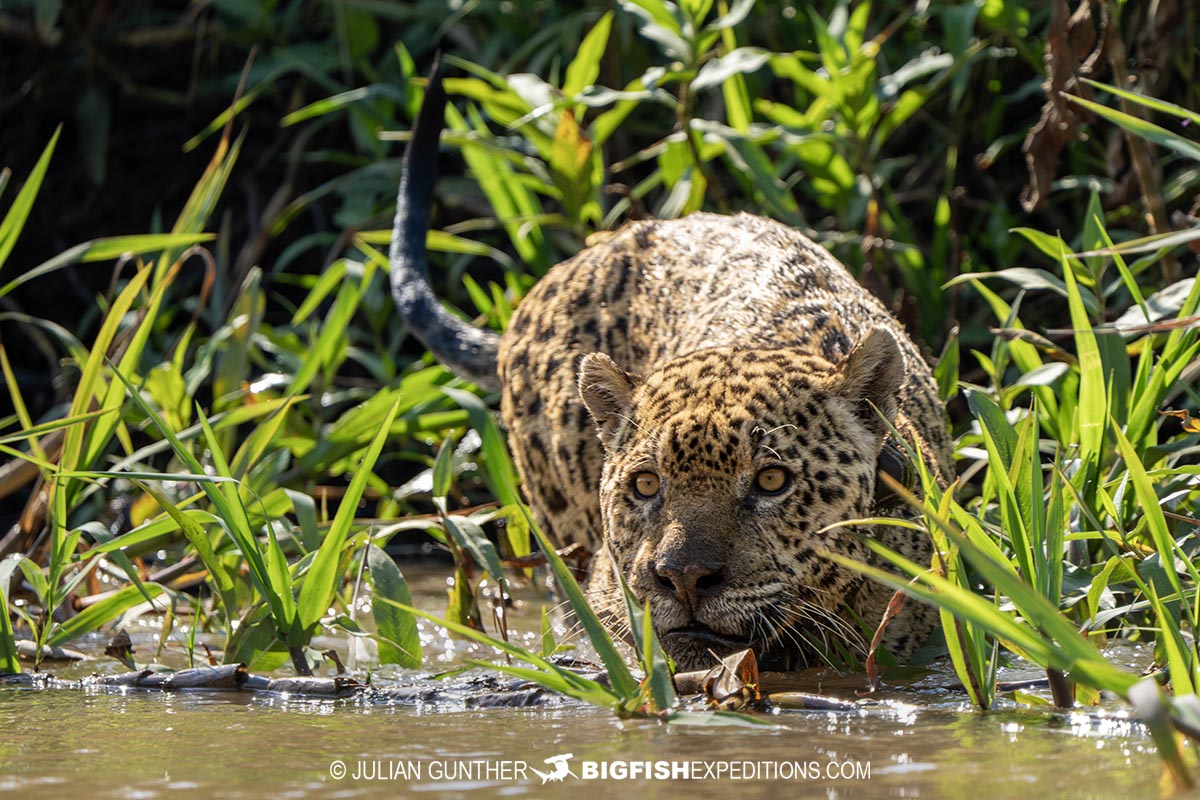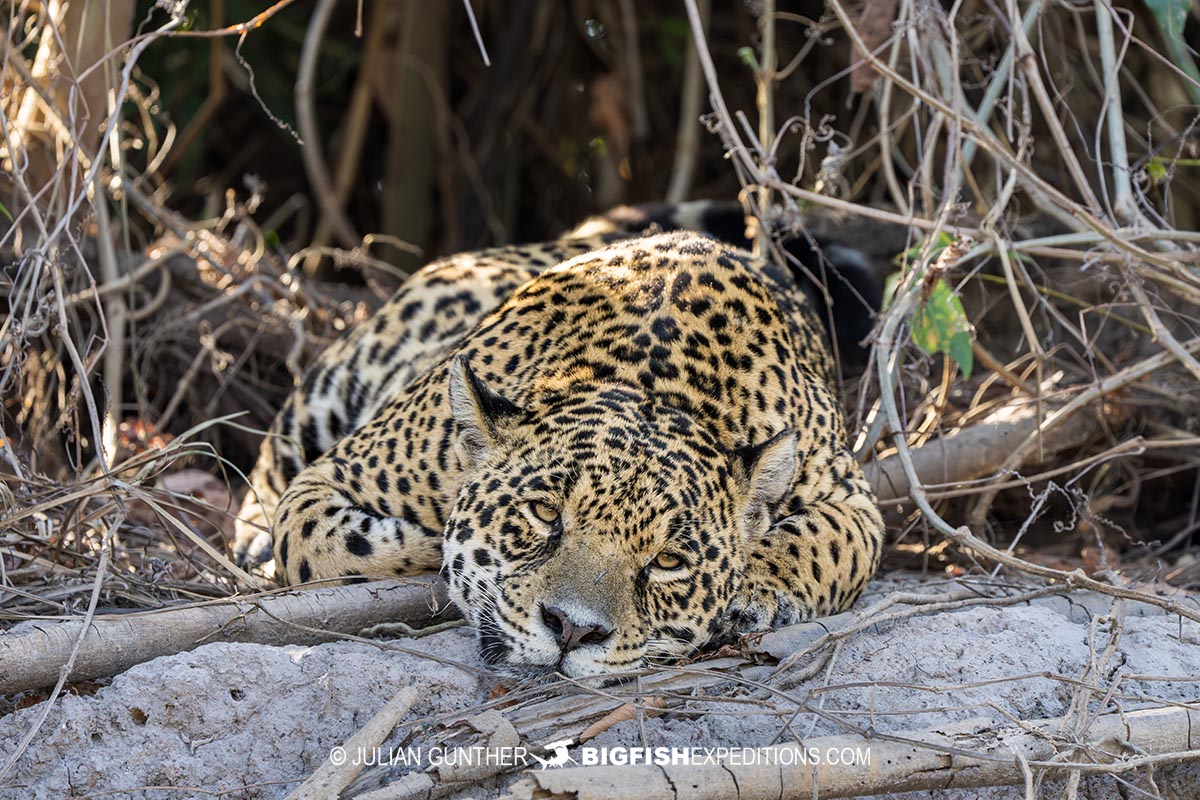A Big Fish Expeditions Trip Report
By BFE Trip Leader Julian Gunther

In Search of Brazil’s Magical Jaguar
Brazilian mythology is replete with tales of magical creatures that inhabit the Pantanal, with none more captivating than the Jaguar. Despite often being overlooked by its Asian and African relatives, the American Jaguar is actually the third largest predatory cat in the world, and nowhere is it more abundant than in the northern Brazilian Pantanal. Once again, Big Fish Expeditions trekked into this wetland to seek out these apex predators and see what other wildlife the Pantanal would reveal.
Day 1: Journey along the fabled Transpantaneira
Our group was picked up from Cuiaba, on the morning of September 5, for the approximate four hour journey along the fabled Transpantaneira Highway en route to the Santa Rosa lodge, near the town of Pocone. What was predicted to take four hours turned into a six hour journey, due to the abundance of wildlife along the route. We encountered Crab-Eating Foxes, hundreds of Spectacled Caiman, Rheas, and all manner of avian life, so there were quite a few stops along the way. Upon arrival we quickly settled into our rooms, set up cameras and batteries to charge and had an early dinner as days in the Pantanal start before sunrise.



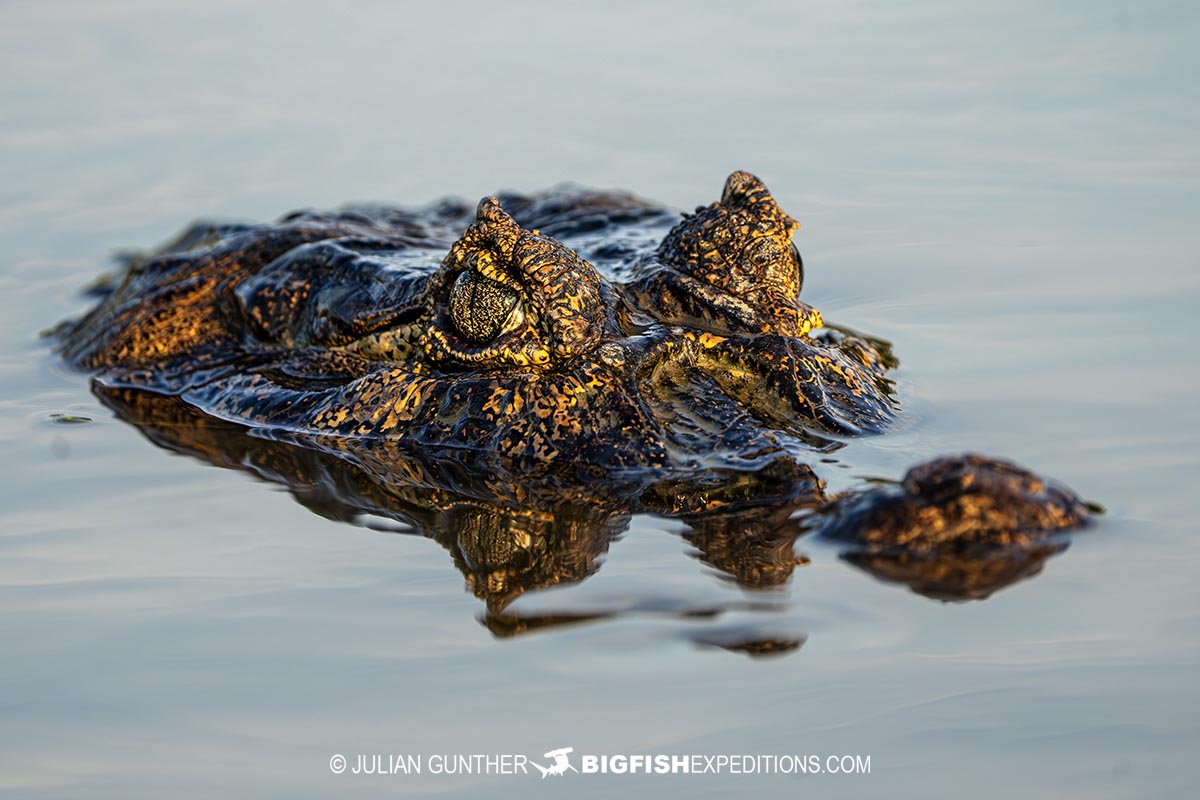

Day 2: Seven Jaguar Encounters and a Yellow Anaconda!
The next morning we awoke while it was still dark, had an early breakfast and headed down to the dock to settle into our boat for the next several hours. It only took about 30-45 minutes to find our first Jaguar, a sleepy male named Pantaneiro. He was situated on an elevated riverbed, sleeping among dense leaves and vines. Pantaneiro occasionally opened his eyes and looked up, but seemed to be enjoying a bit of a sleep-in, so we continued downriver to search for more animals. About 30 minutes later we came across another male, Ousado, who was patrolling the elevated riverside. Once Ousado disappeared into the underbrush we found the female Jaju. She was actively hunting, albeit unsuccessfully. We followed Jaju for almost an hour as she alternated between swimming along the water’s edge and walking on the shoreline. We then received a call that two jaguars were resting on a riverbank. As we headed in that direction we came across a Yellow Anaconda swimming in the middle of the river. Yellow Anacondas don’t grow as large as their green cousins, but are still very large for a snake. This particular individual was just over 6ft (2m) long. After a while we realized it had been injured which was why it was swimming so erratically. We left the Anaconda alone and headed to our jaguar pair. As we arrived we suddenly saw jaguars Patricia and Makala, a monther-daughter pair, resting in a shaded area along the riverbank. Although Makala was Patricia’s daughter, she was no longer a cub and both animals are adult-sized. They spent most of their time relaxing, occasionally getting up and going for a quick patrol of their small stretch of river, but then retreated back to the shade. After some time with them, we then encountered the male, Ipepo, and one other unidentified Jaguar, before heading back to the lodge. In total, there were seven individual Jaguar sightings, one anaconda, and countless birds, caiman and capybaras.
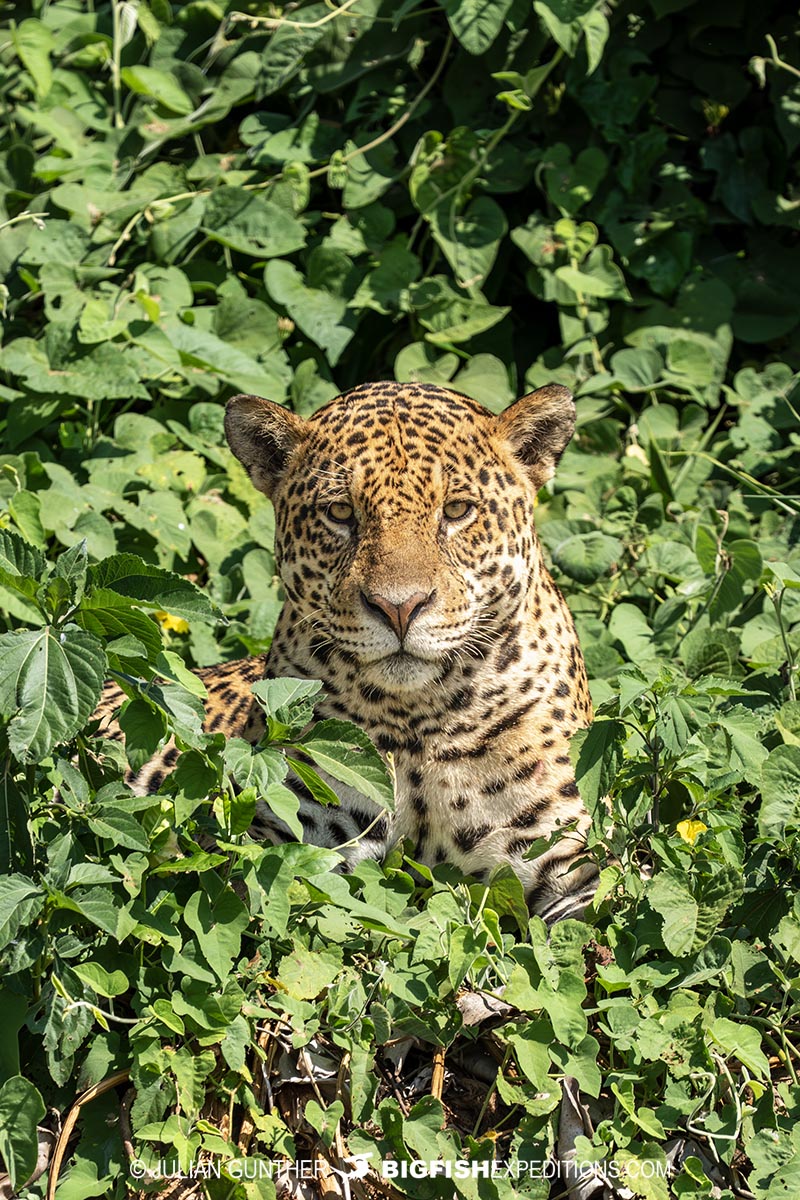
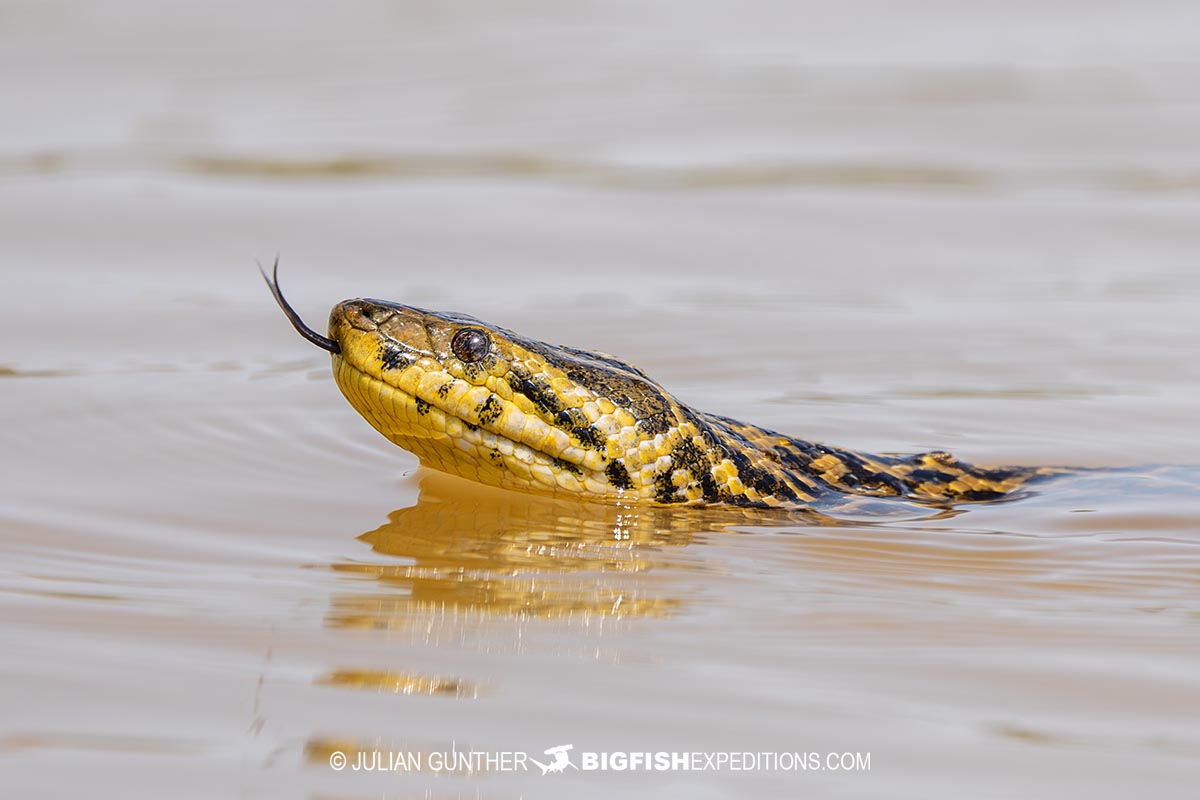
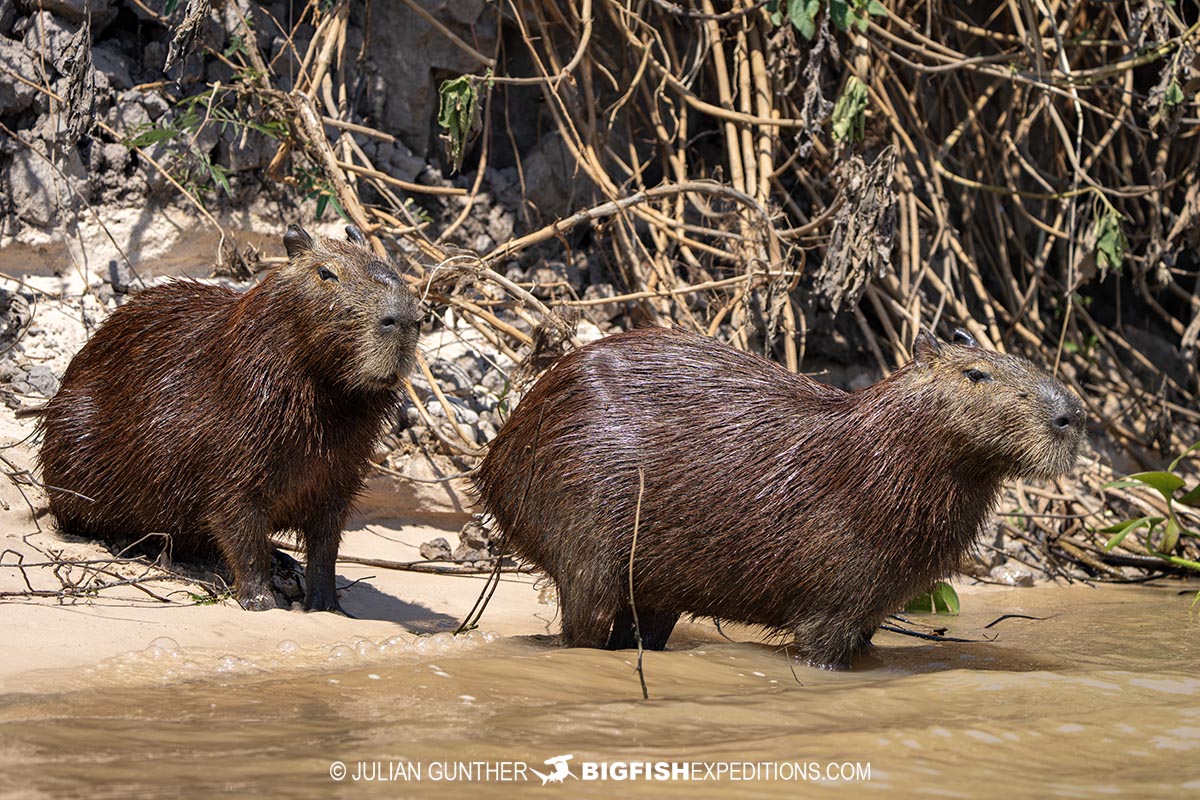
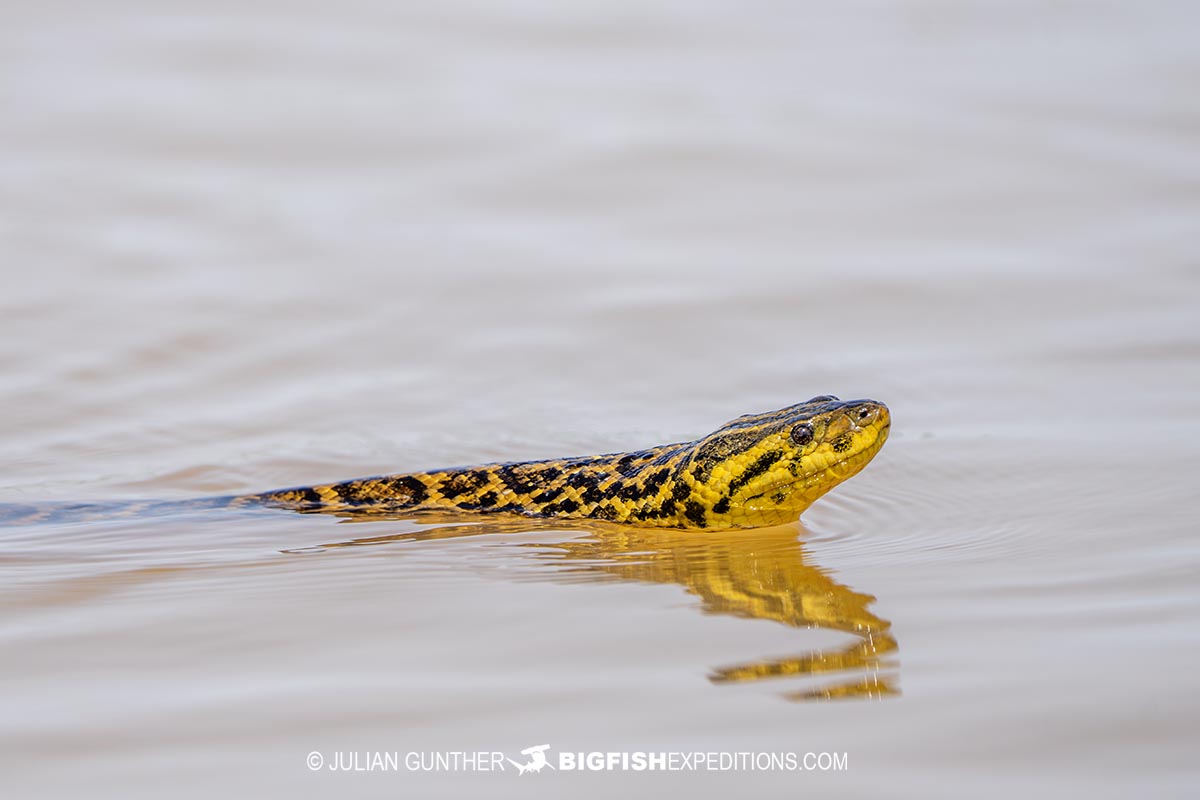
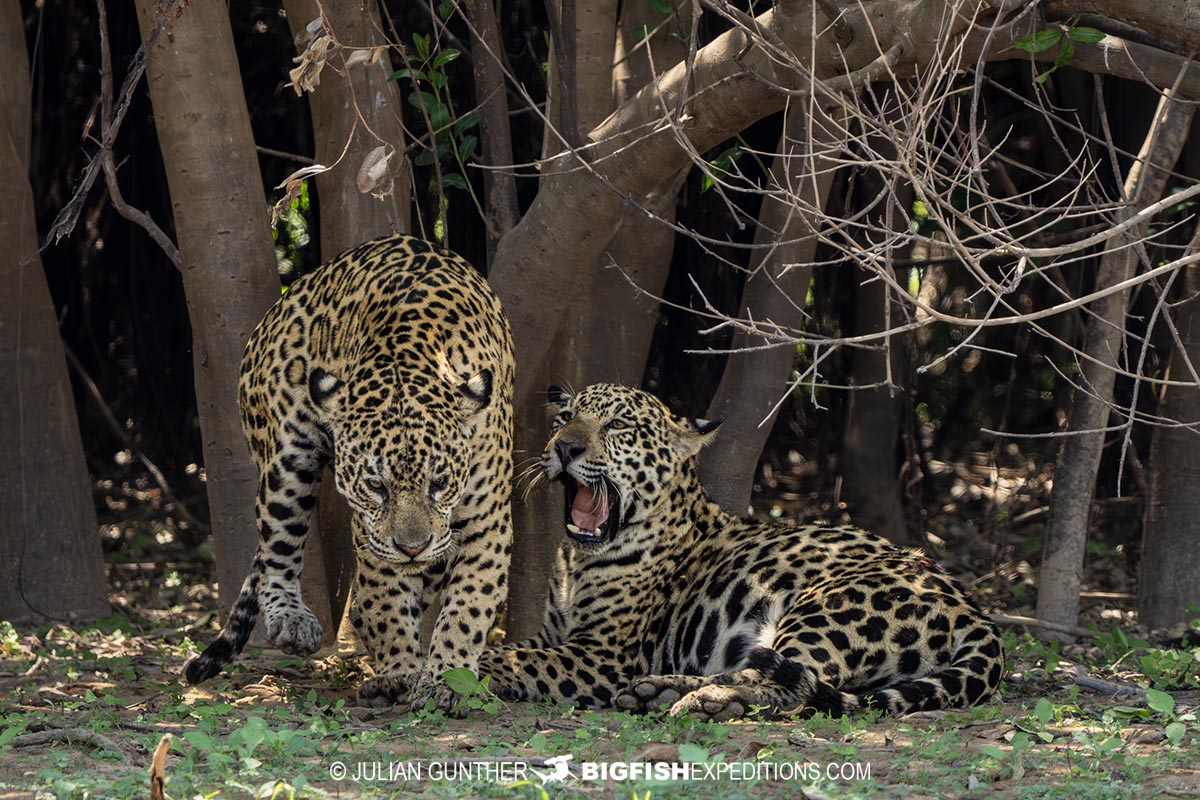
Day 3: Giant River Otters hunting for fish and Six more Jaguars!
Day two started off very similar to the first, with an early rise and breakfast, but within ten minutes of leaving the dock we encountered a group of three Giant River Otters, actively hunting along the riverbank. Although Jaguars were our main focus, its hard not to want to follow these large aquatic animals as they frolick in the water. Giant River Otters are hard to take seriously, they seem to swim without a care in the world, squeaking and chirping, while tumbling and rolling, and then suddenly they will appear with a fish in their mouths and quickly consume it. We were fortunate to see this group catch 1-2 fish in the span of a couple of minutes. After the otters disappeared into a shallow channel, we continued our search for Jaguars and were rewarded with six individual encounters throughout the day. Medrosa, Ousado, Marcelo, Forasteiro, Patricia and Saseka were the individual we saw on day two. Forasteiro was the most formidable sighting. He is a very large male, clearly one of the dominant alphas in the region. Lucky for us, he was resting along a very narrow riverbank with an unobstructed view. In fact, we were able to get such a good view, we had to limit our proximity due to safety reasons!
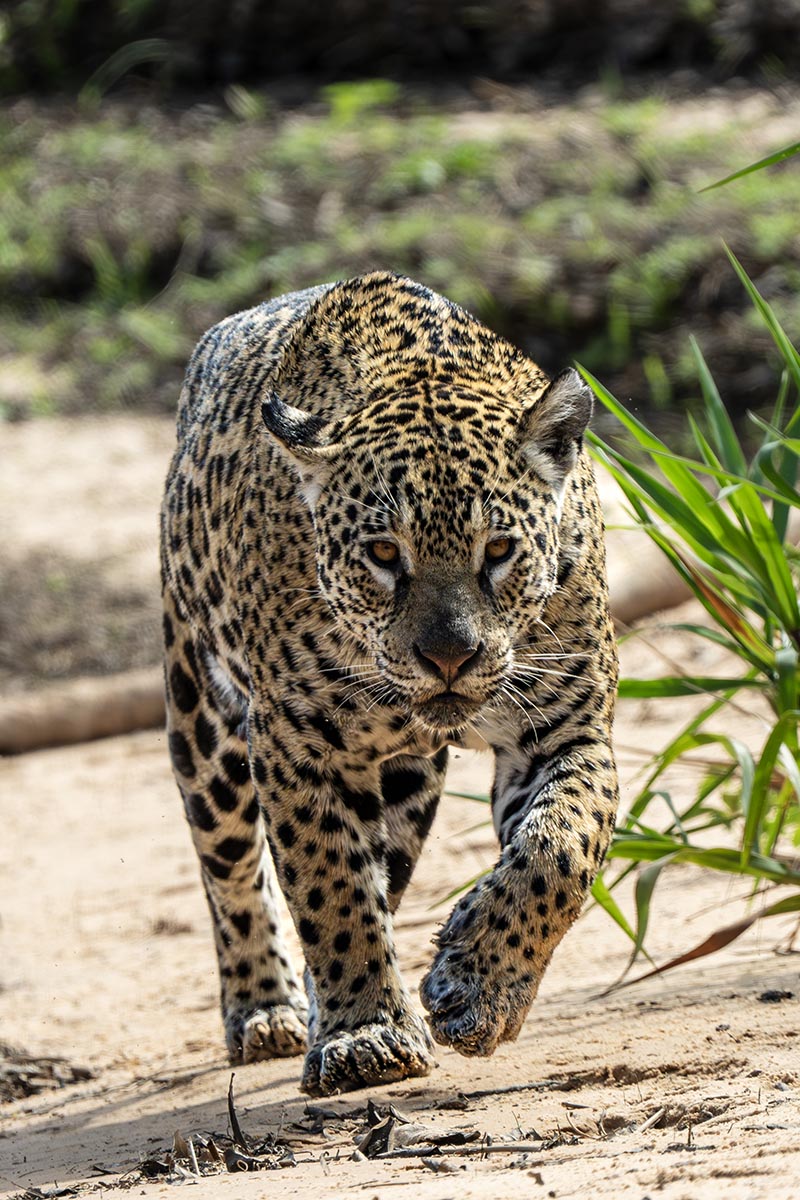

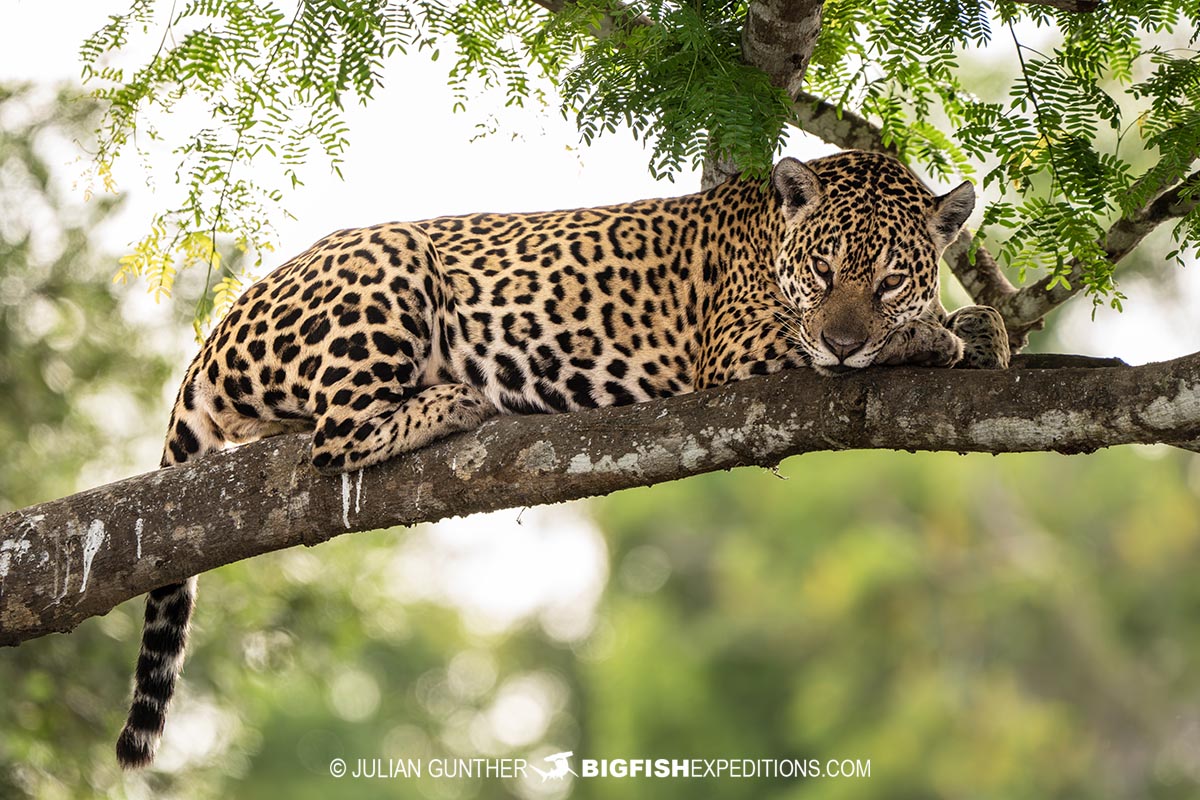
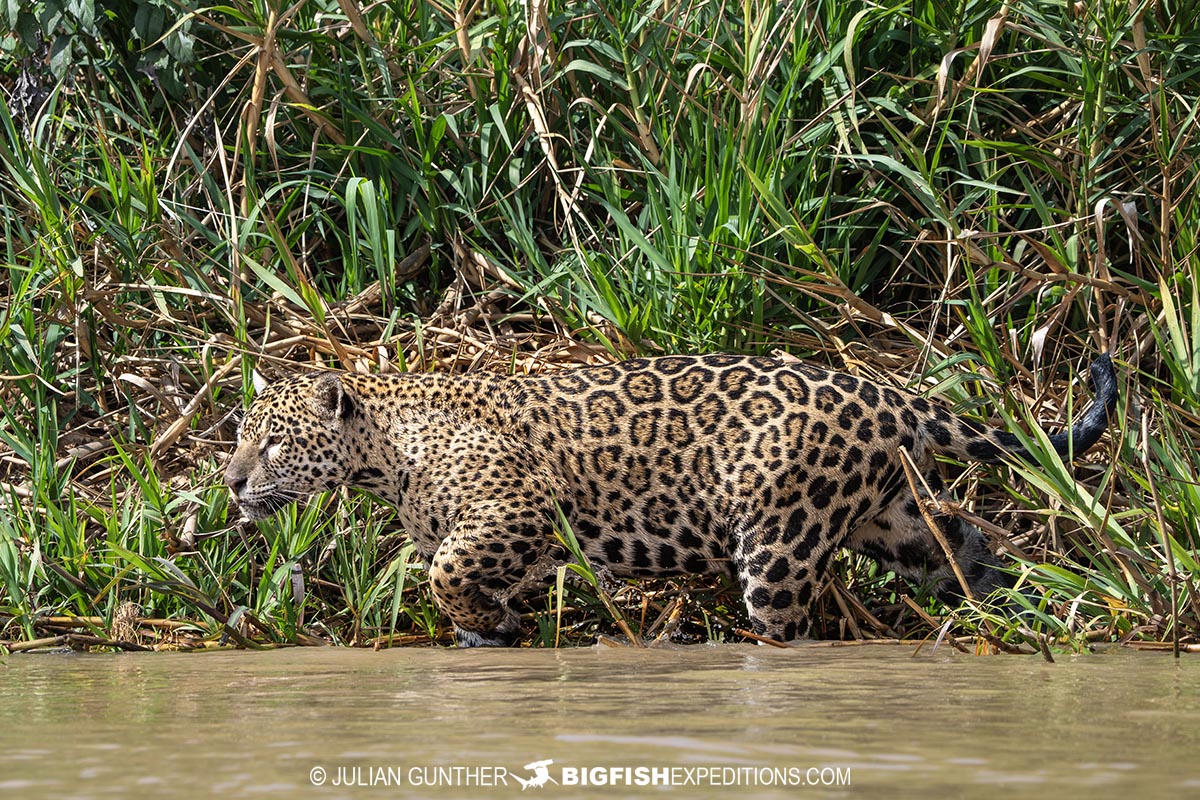
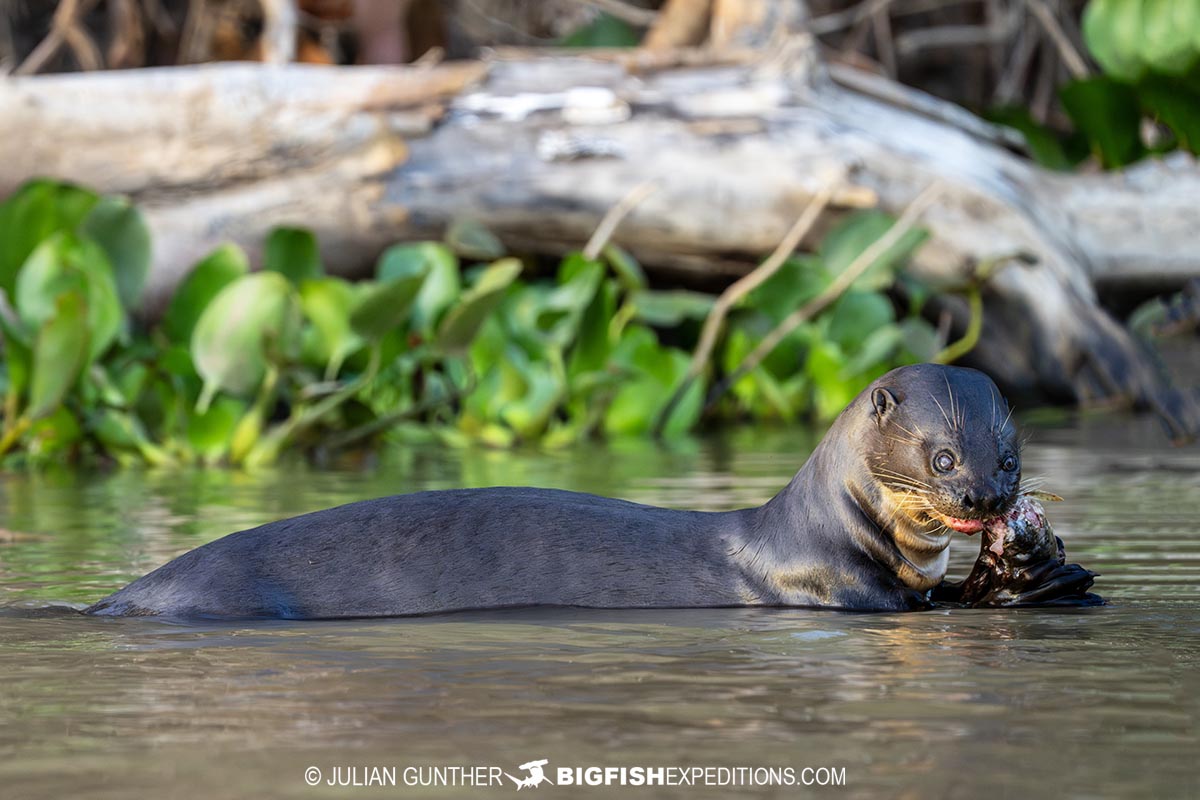
Day 4: Great Jaguar Encounters in the Pantanal wetlands.
September 8 was scheduled to be our last, dedicated Jaguar day before moving on the the next lodge, and given the number and quality of sightings from the prior days we were preparing ourselves for a potentially slower and less adrenaline-fueled day. If you spend enough time photographing wildlife, such sentiment isn’t uncommon, after great encounters, you know eventually things will settle down. Given the way that day started it seemed to be the case, but later we were proven epically wrong. It took us about an hour to find our first Jaguar, once again, it was Patricia, and she was relaxing on a thick tree branch that hung over the river. She occasionally stretched and repositioned herself, before eventually heading into the thick underbrush to search for a meal. As we continued throughout the day, we came across jaguars Pantaneiro, Bajua and Birnard, for a then-total of four individuals. That figure wasn’t bad, especially since most encounters lasted a minimum of 30 minutes, but not near the levels we’d been accustomed to from the prior days. We also encountered a pair of Giant River Otters who were playing outside their den. They seemed oblivious to us as they frolicked and ate fish.



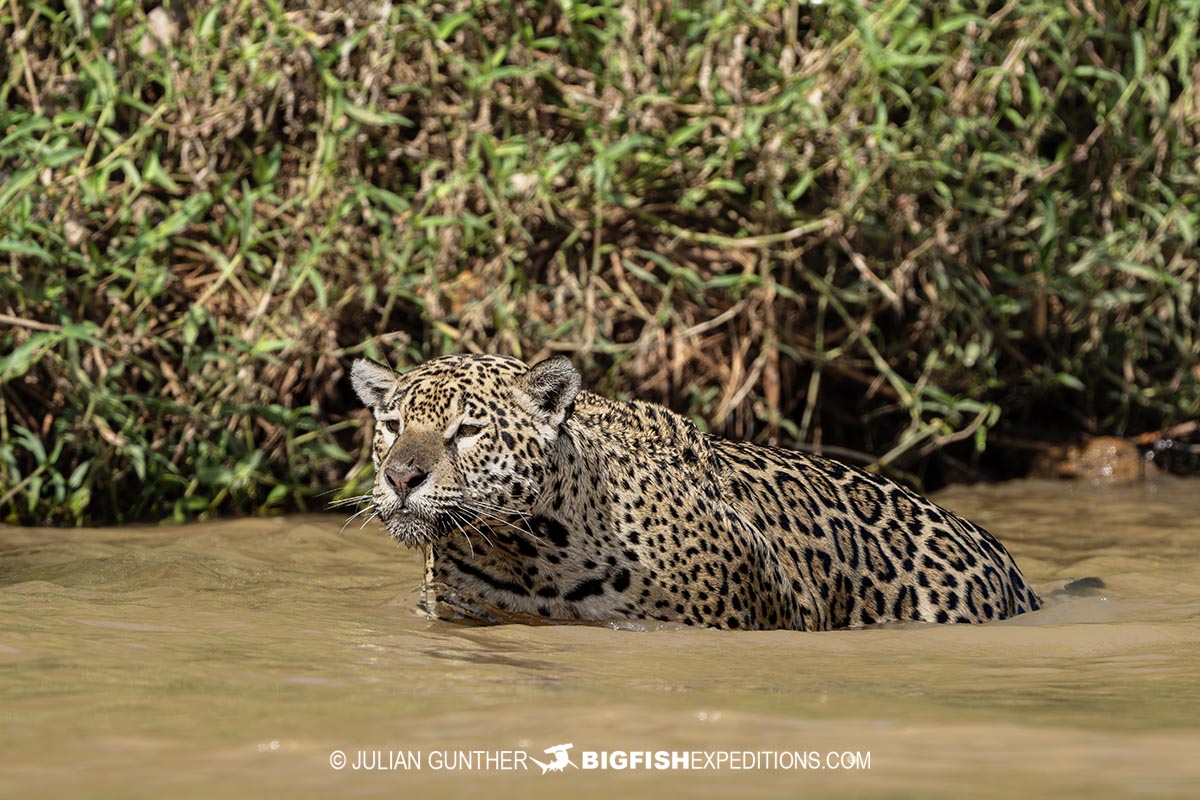
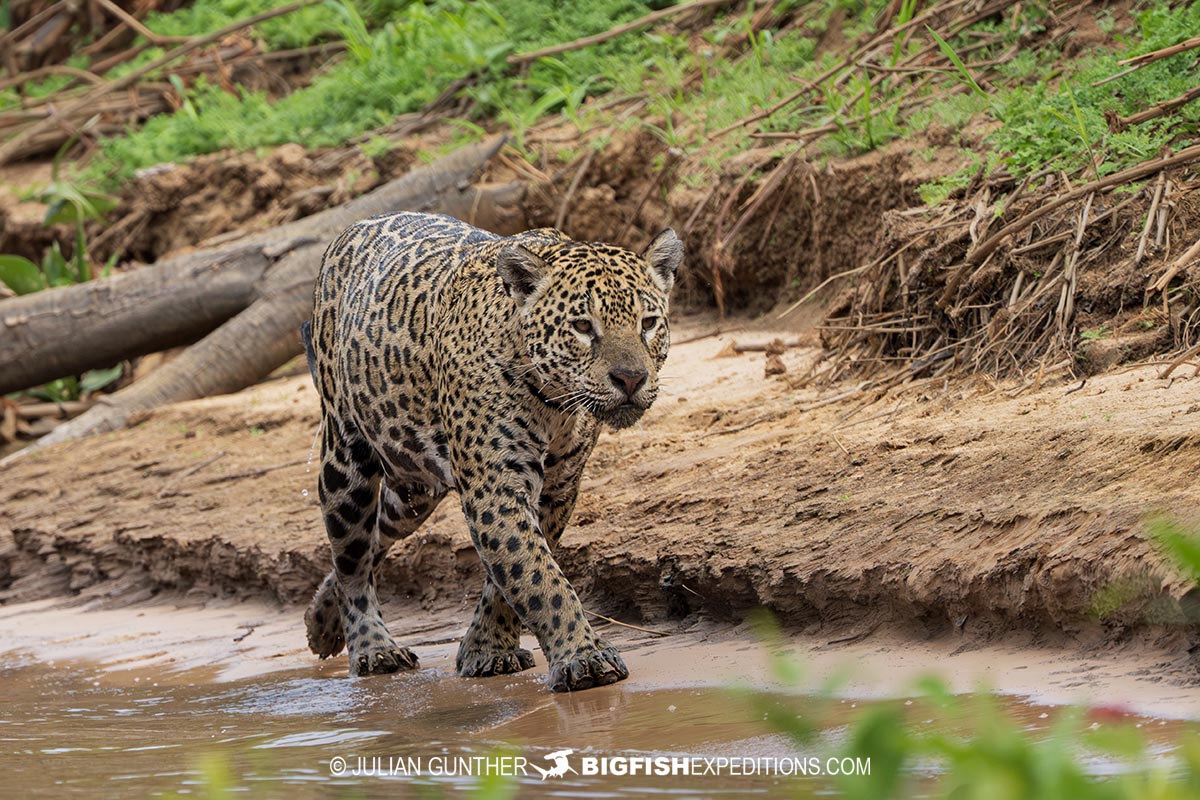
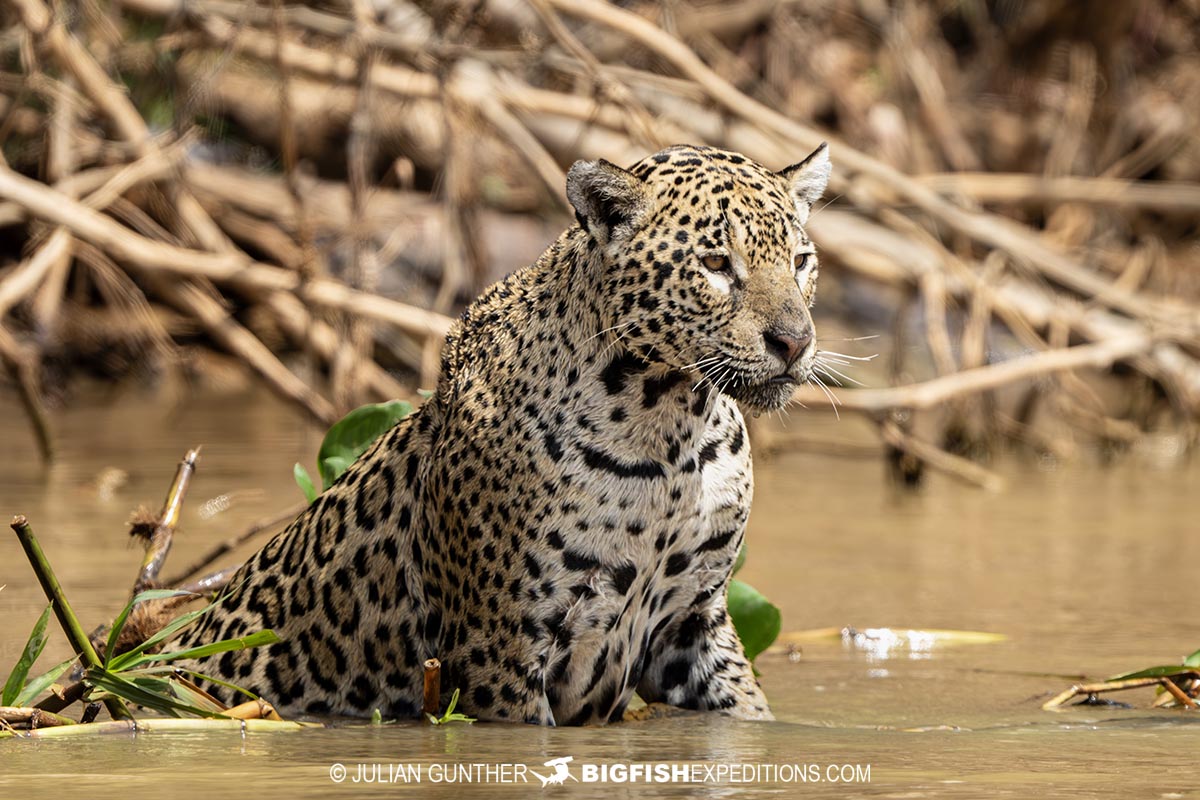

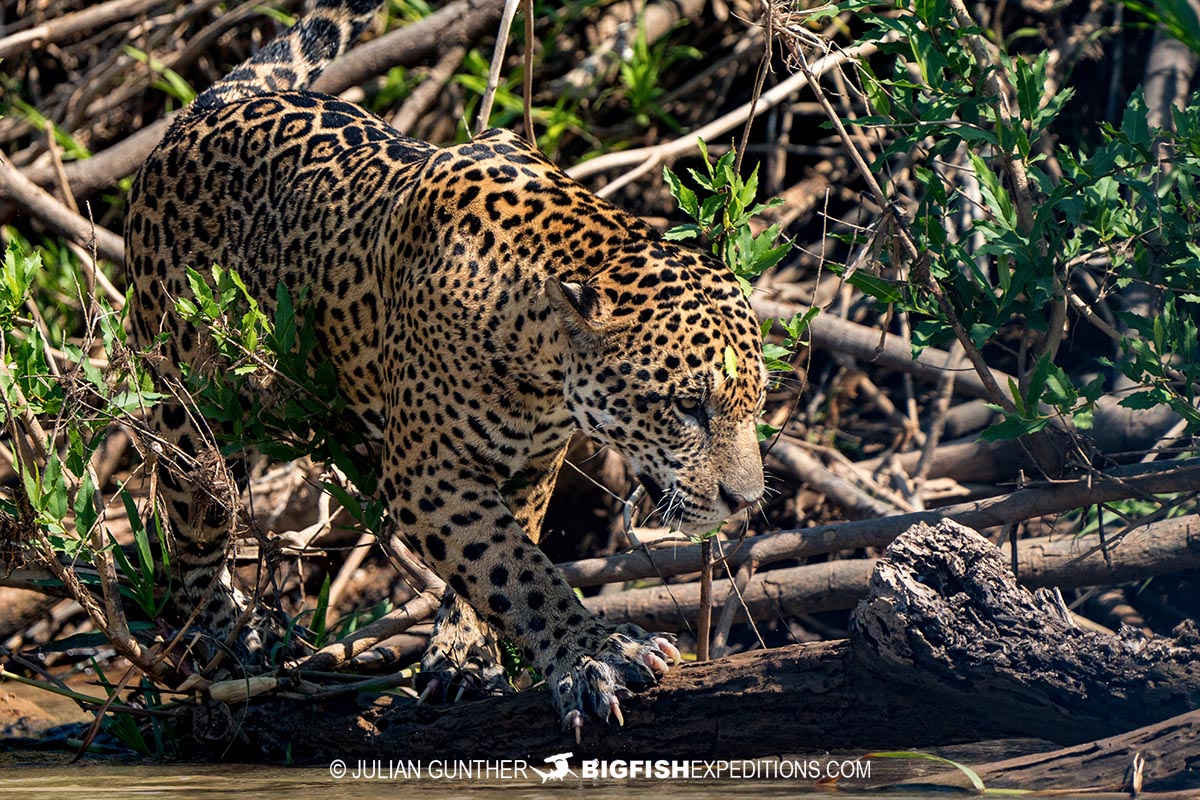

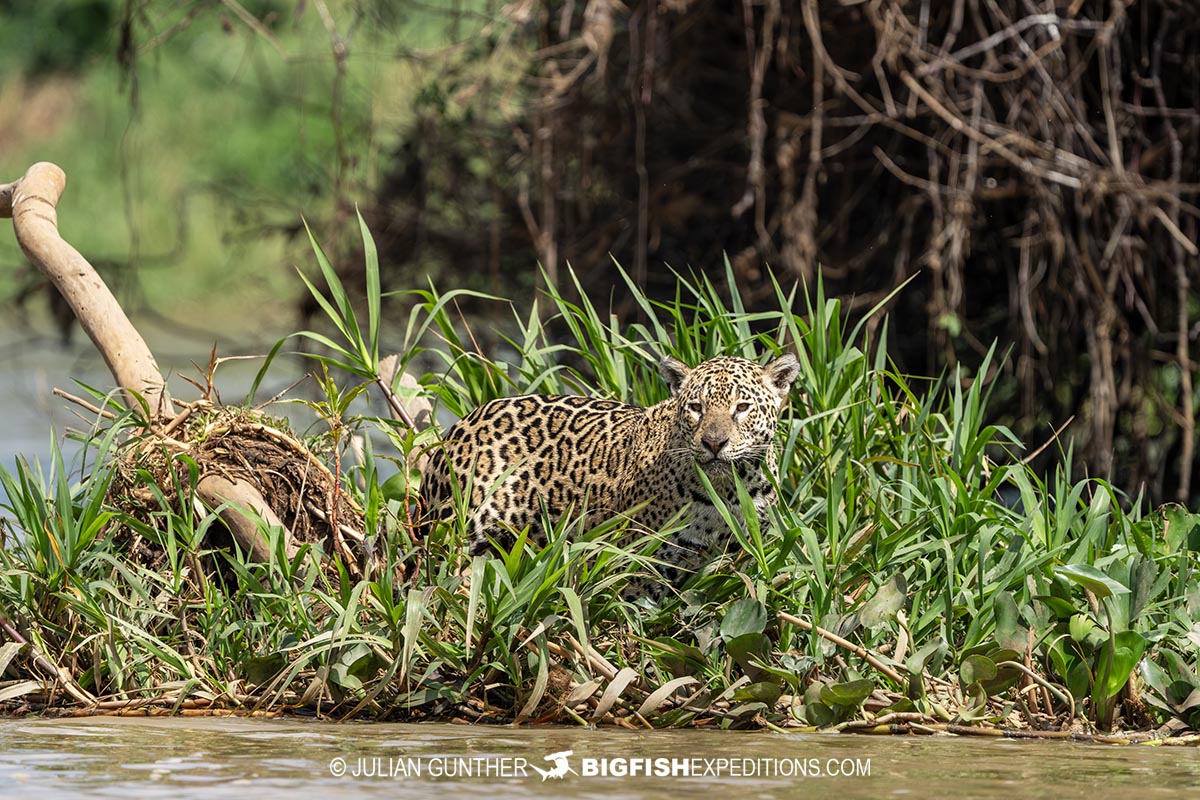
Jaguar Predation!
As the afternoon wore on, we motored down river, looking and hoping for another jaguar. We then came around a bend, at a relatively high rate of speed, when suddenly one of the guests pointed and yelled “holy ^%$*ing *&^%!!!”
…and there on our port side was Jaju, a nine or ten year old adult female jaguar, sitting on top of an 8ft (2.4m) Spectacled Caiman!!! The two wrestled for a bit on the water’s edge, as Jaju tried to position herself for a paralyzing bite to the caiman’s neck. Jaguars can exert 1,500 pounds per square inch of bite force, the strongest of all the big cats. We were fortunate that we were the only ones witnessed to this rare spectacle and thinking back, it was comical as the only sounds you heard on our boat were disbelieved-profanity and the clicking of camera shutters. Jaju was able to deliver a paralyzing bite, but then had to contend with another problem; how to move the caiman. This particular reptile was much larger than the female Jaguar and she was going to have to drag it up a very steep and tall riverbank. Jaju struggled and had to stop to occasionally reset her grip and rest, but was eventually able to lift the caiman up the bank and into the thick underbrush. We all high-fived each other and jokingly (maybe a little serious) suggested going up the riverbank to watch her feed. This event exceeded everyone’s expectations and we then set out downriver to try and find a Tapir. We had jokingly said that if we had time and we got everything we wanted, we’d go try and find this shy, large herbivore. So with about an hour of daylight left, we figured we’d give it a try, and about 15 minutes later we found one drinking along the riverbank!!! It then swam across the river, directly in front of our boat, and back into the underbrush. Once again, expectations exceeded!!!
We then returned to the lodge, still high on the events of the day and realizing we still had more to come.
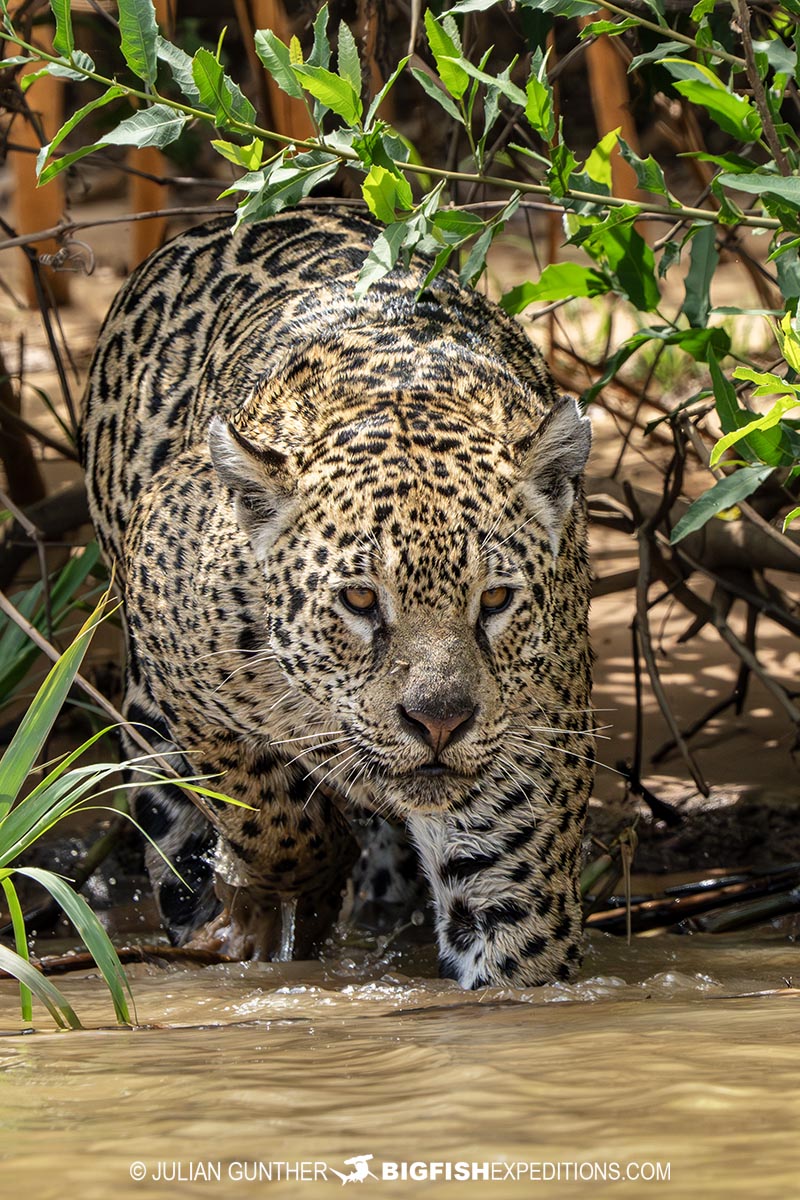
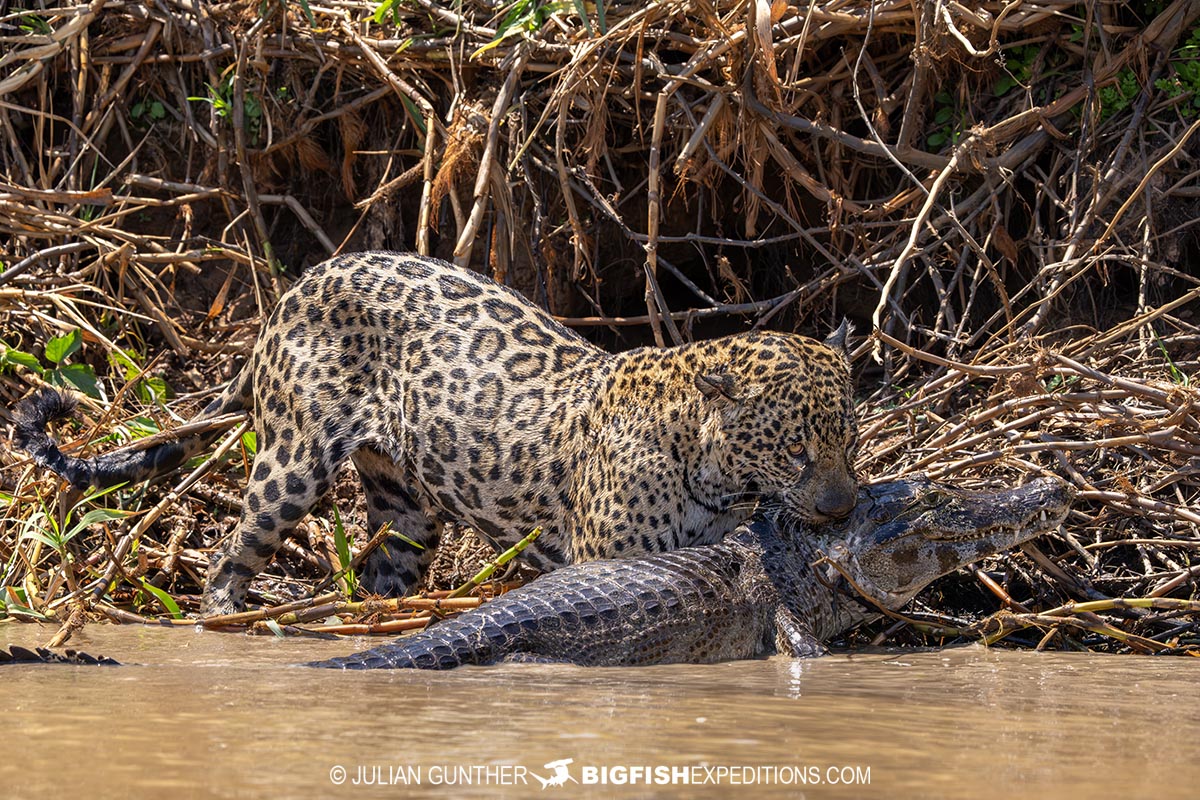
Day 5: Monkeys, Otters, and Epic Bird Photography on the Rio Pixaim and our first night with Ocelots!
For the remaining two days of our expedition we relocated to the Santa Tereza Lodge, along the banks of the Pixaim River. Although Jaguars are still around, they are not as commonly sighted as in our prior location; however, there are greater densities of other animals such as Giant River Otters, Birds, Monkeys and our primary target, Ocelots. Upon arrival we immediately search out a nearby Jabiru nest. Jabirus are tall white, black and red birds, and there are several nests near the Santa Tereza Lodge. In one particular nest there were four hatchlings and we got to watch (and photograph) as the parents took turns leaving the nest for water and fish for their young. We then went out on the river to watch Kingfishers, Hawks and other birds dive into the river to catch fish. As the sun dropped on the horizon we prepared for our search for Ocelots. There is one location near the lodge that is a partial wildlife-blind, where Ocelots can be readily seen. We settled into our seats and wait as darkness fell. Suddenly there was movement in the background and slowly a female Ocelot materialized out of the darkness. She seemed almost accustomed to having her photo taken, I say almost, because on occasion she would freeze and suspiciously look in our direction. After a while, she retreated back into the darkness and we headed back into our beds for the night.

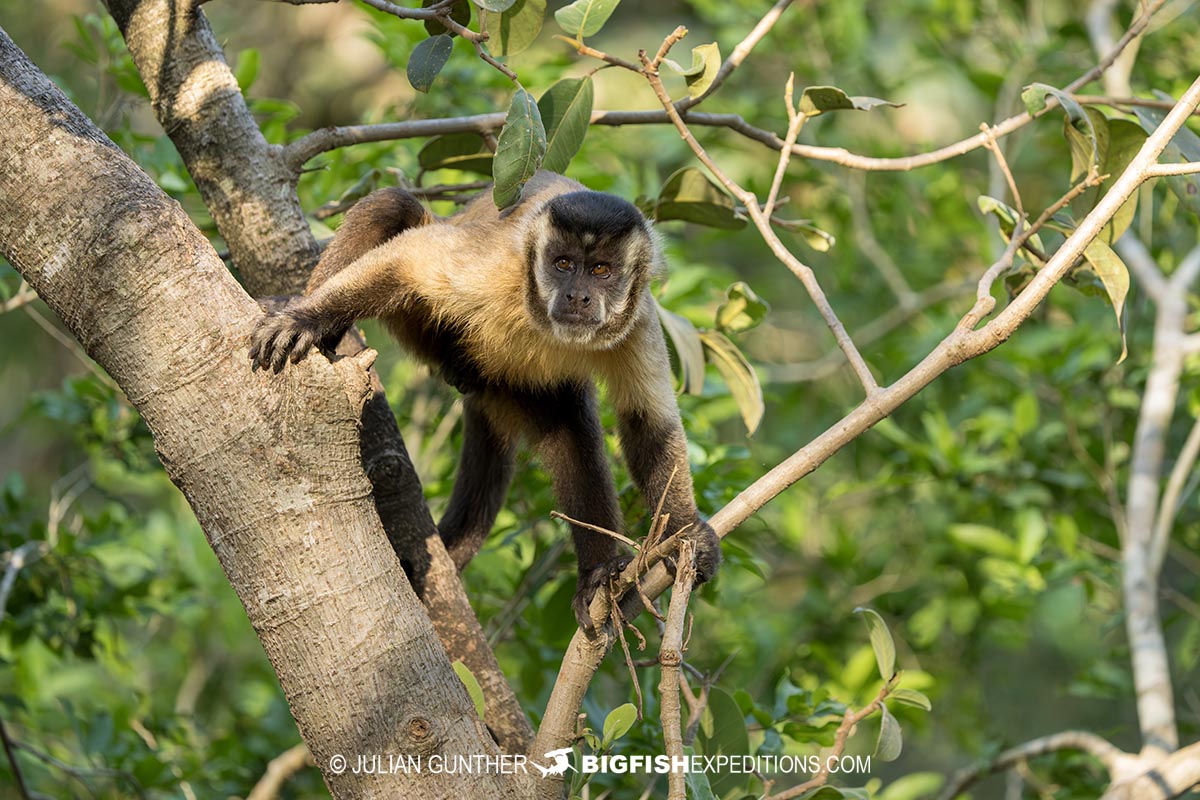
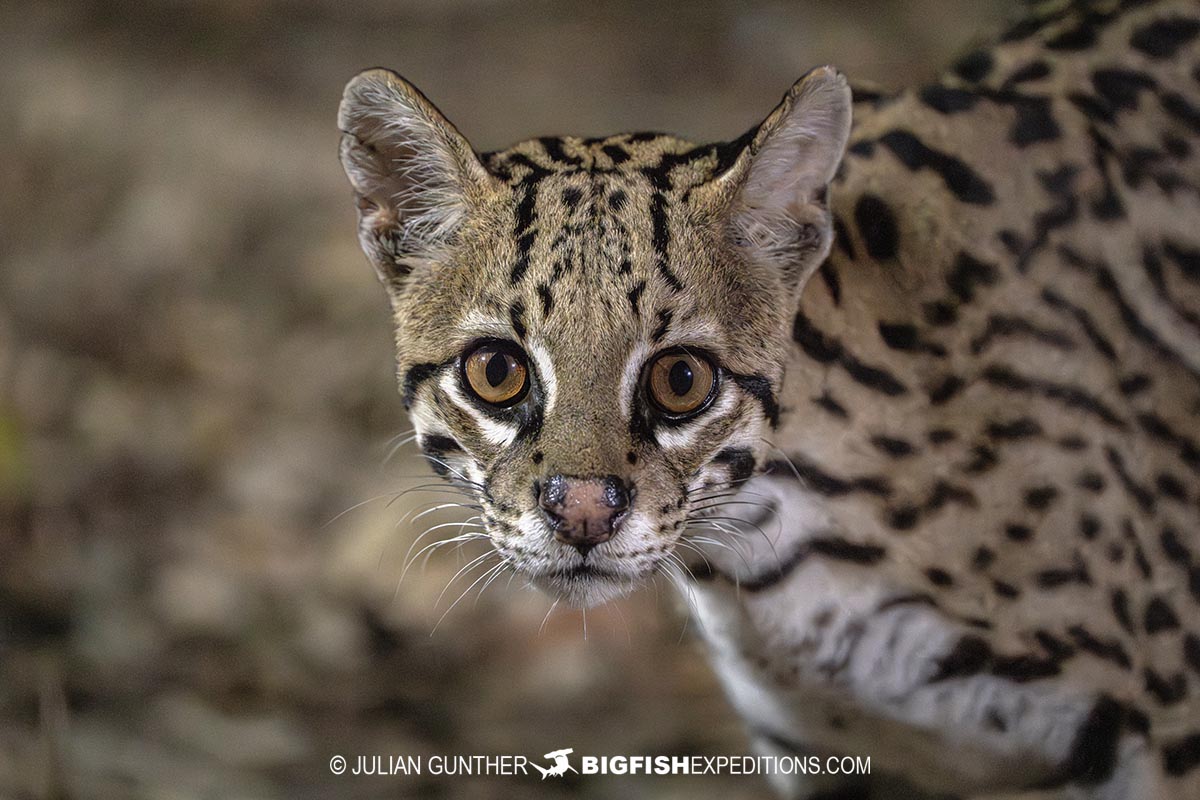

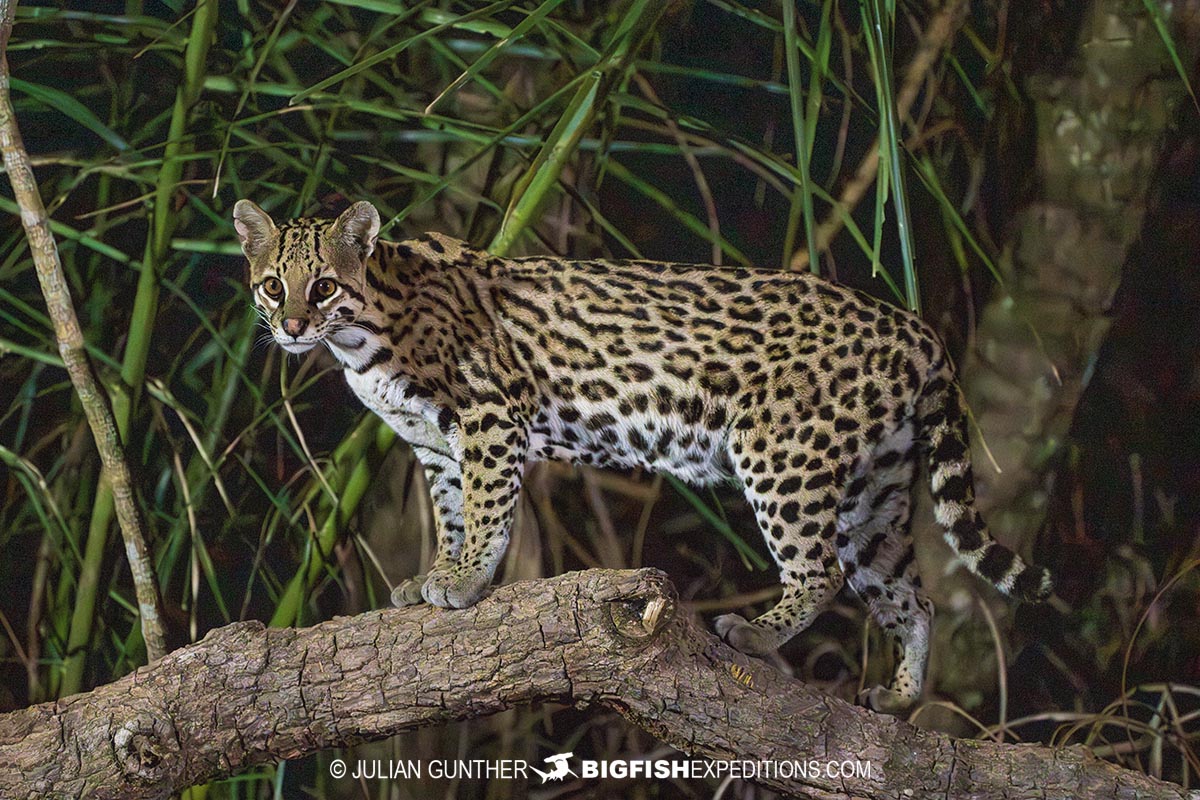
Day 6: Chasing primates, a walk in the jungle, and another amazing Ocelot Encounter
Our second day at Santa Tereza started early as we had planned on going to shoot Howler Monkeys. We headed into the bush, but the Howler Monkeys didn’t seem interested and stayed high in the trees. However, smaller Capuchin Monkeys were very interested and followed our group, en force. After a prolonged morning and now-low camera batteries, we left the capuchins and headed back to the lodge for another day on the river looking for birds, caiman and whatever wildlife we could find. Once again, everyone had an opportunity to try and shoot Kingfishers and other birds as they dive-bombed into the water for a meal. Later that evening we headed back to our blind for (hopefully) another opportunity at an Ocelot. We sat for much longer this time and unfortunately started growing a bit disillusioned thinking our feline friend might not show, but she was just getting a late start and eventually came across our path again. She seemed wary, but that proved fortuitous because she would often pause and look directly in our direction which allow us to take some breathtaking portraits. After numerous opportunities, our Ocelot once again retreated back to the jungle and the slow realization came across us that our trip had now concluded.

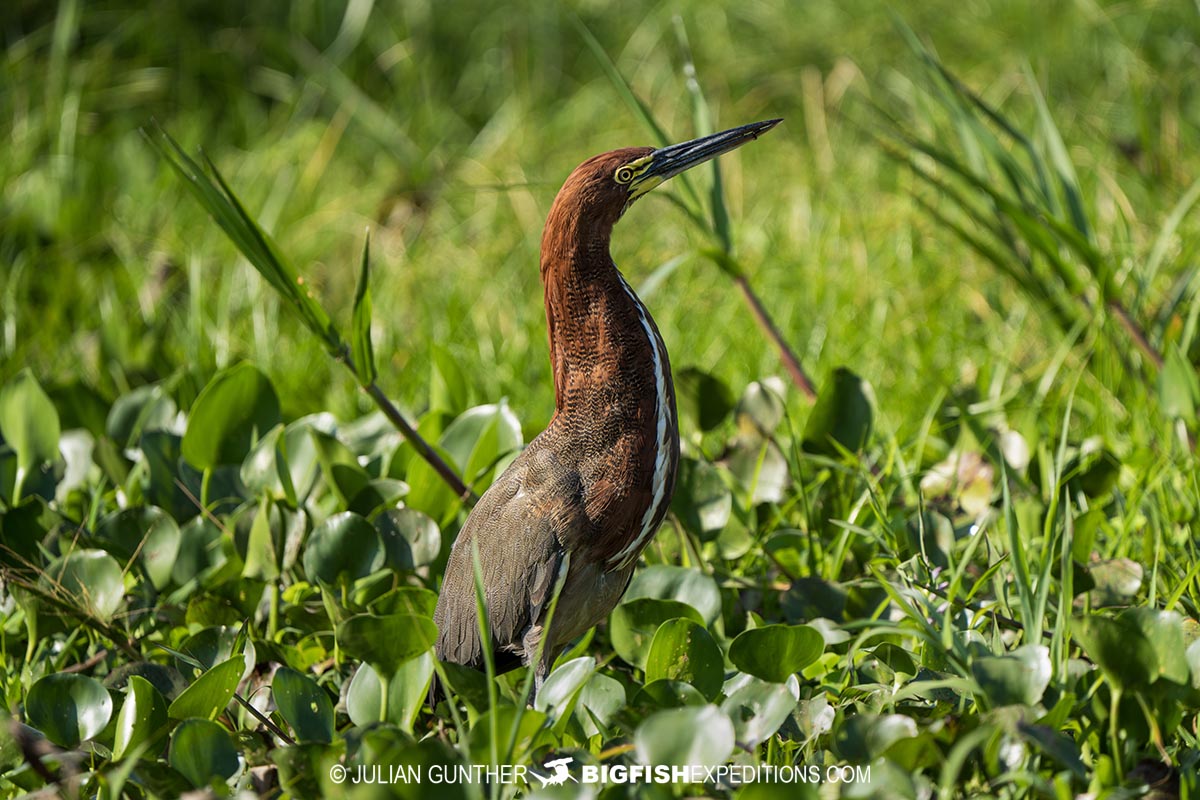
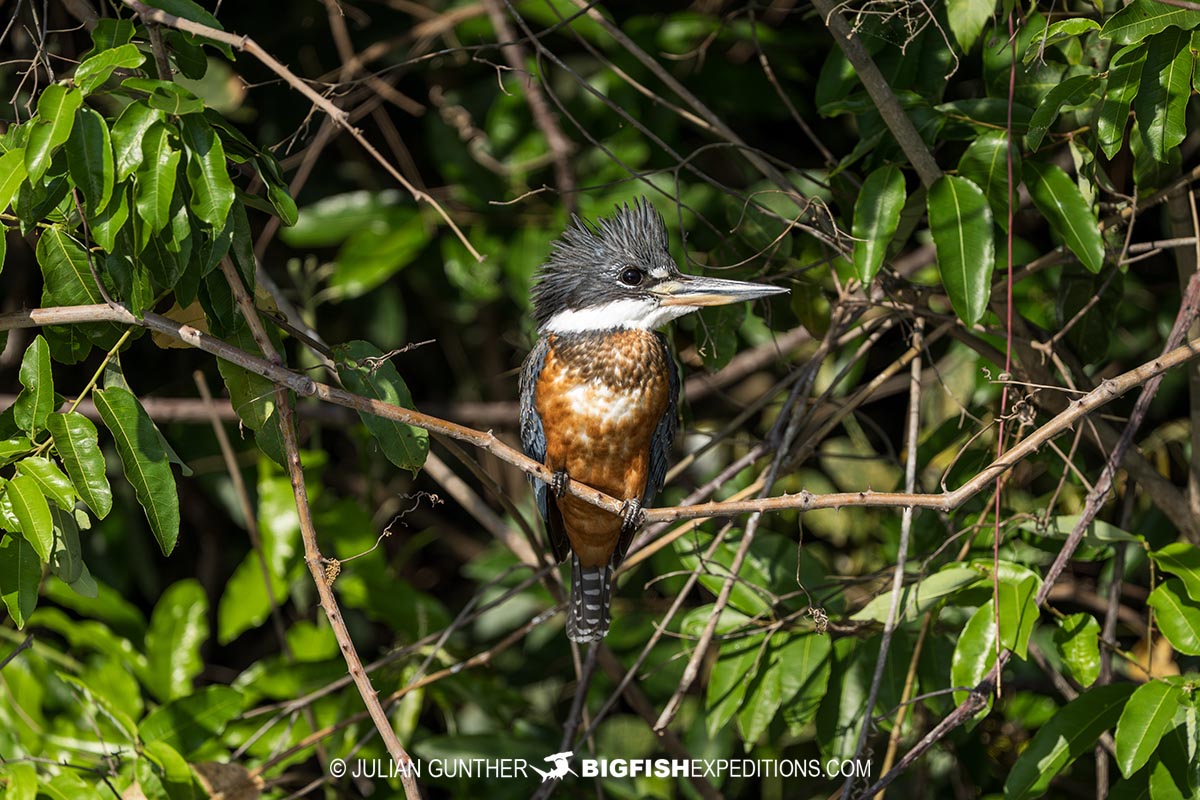
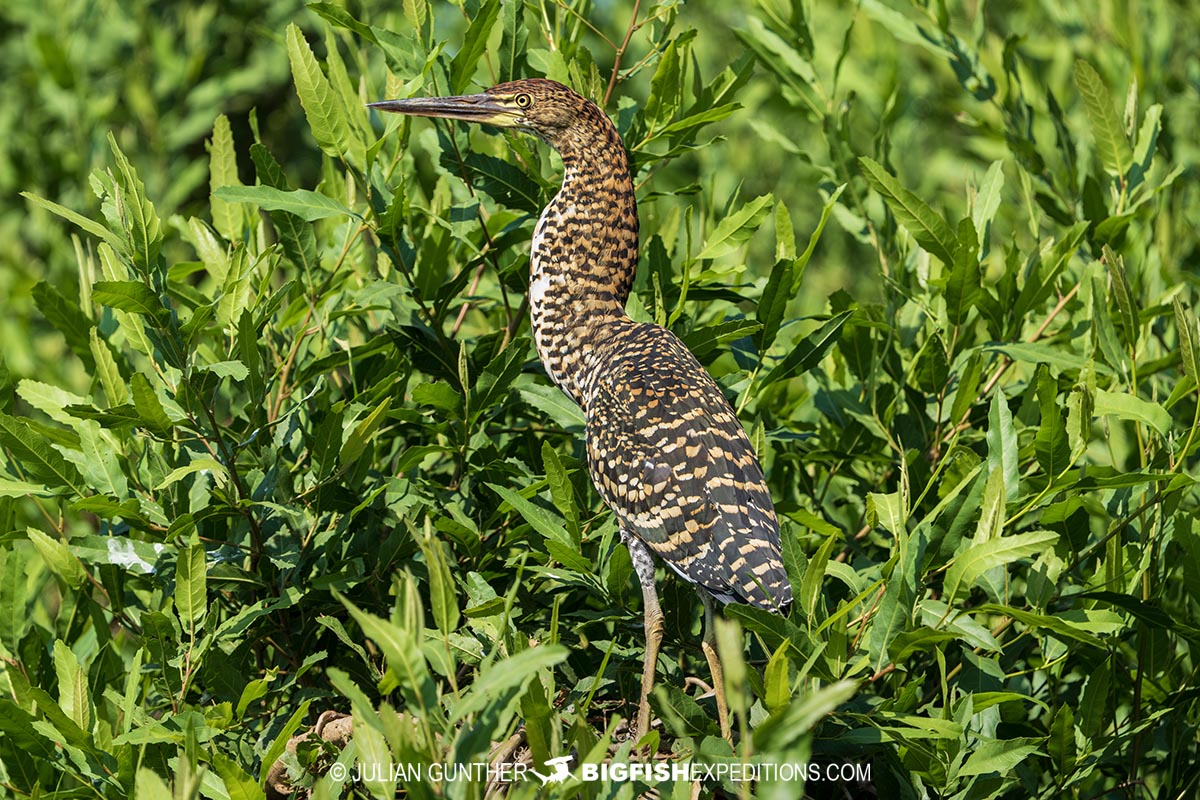

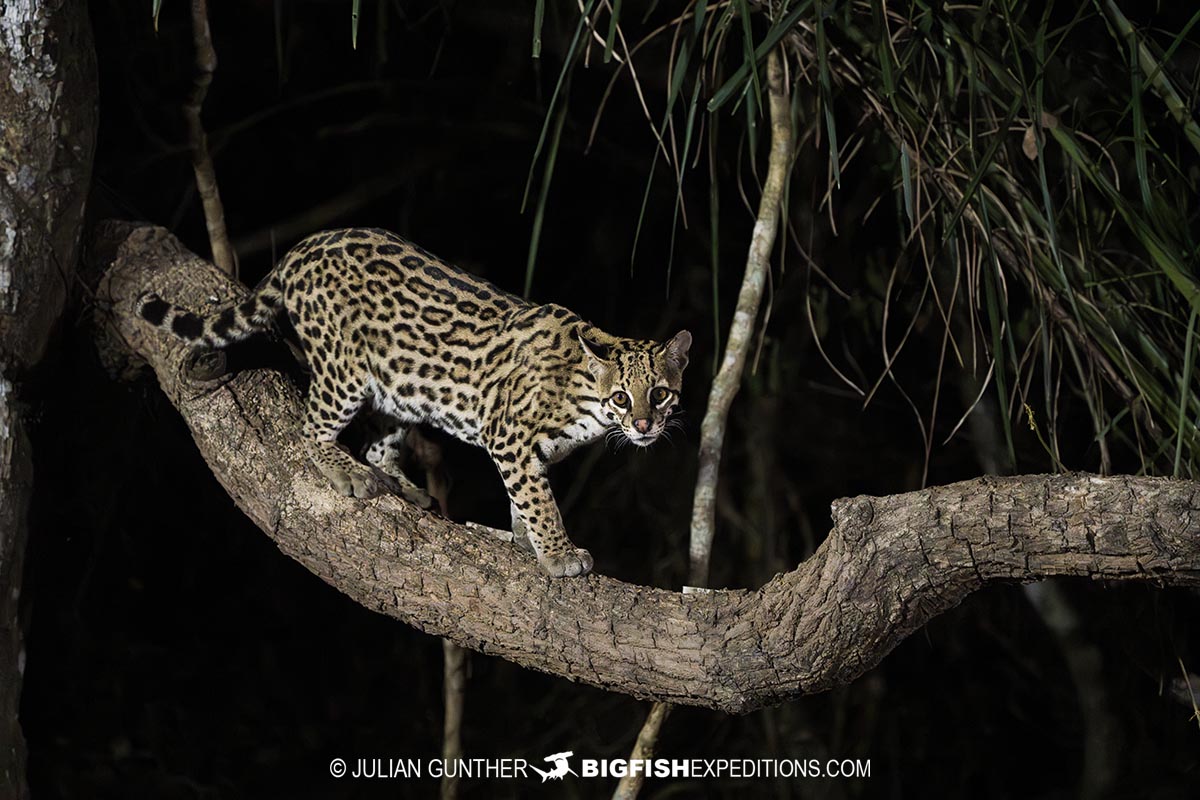
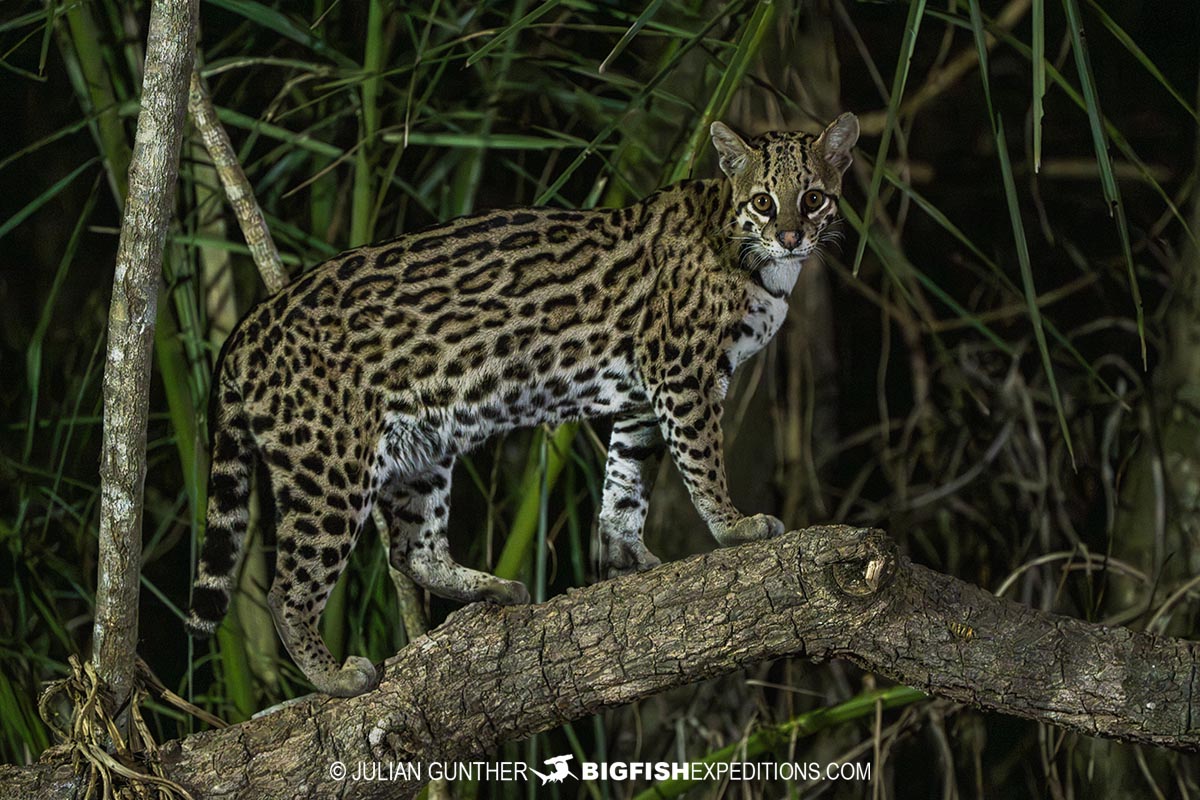
Day 7: Return to Cuiaba
The next morning, on our drive to the Cuiaba airport, we jokingly compared how many images we had taken over the past week (everyone had between 2,000 – 5,000), and talked about our favorite ones. We then hugged and said our goodbyes before beginning our respective journeys back to our homes.
This trip caters to all manner of photographers and videographers, from professionals to those that just recently picked up their first camera. If you fall into the latter category and wish to join our trip, please let your Trip Leader know so they can assist you however possible. During this year’s trip we were routinely calling out our settings so we could compare and help our less experienced photographers. Speaking for myself, it brings me immense joy helping others to shoot photographs they can be proud to share and call their own.
Our 2026 Jaguar trips are both currently full, but we have a couple of spots left in September 2027 if you would like to join us. Follow this link for more information about this epic wildlife adventure: Jaguars of the Brazilian Pantanal
